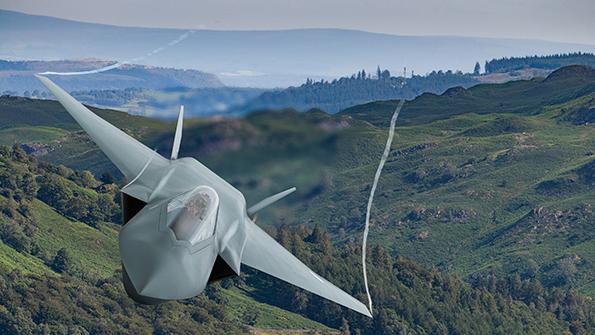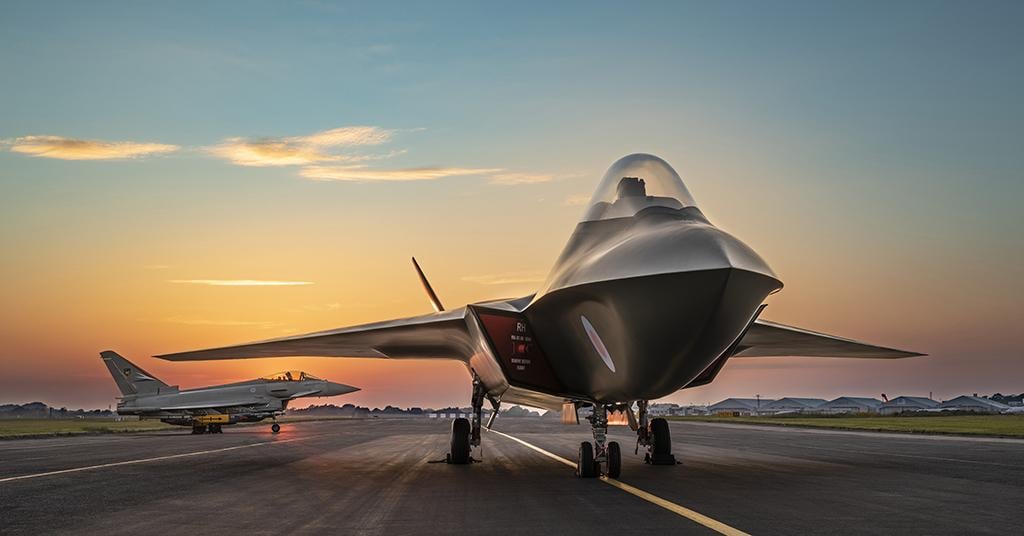
When Japanese Prime Minister Fumio Kishida visited London in May, he suggested that the joint efforts of the UK and Japan on a Future Combat Air System could become the “cornerstone” of their bilateral relations.
What had started in the mid-2010s as studies of radar technologies and a future air-to-air missile has since expanded into work on demonstrators for engine technologies and advanced radar sensors.
- Partnership has expanded to include engine and radar
sensor technology - U.S. had limited the pace of Japanese industry progress on F-2
- FCAS could compete with F-35s for future export deal.
And now that cooperation could broaden further, potentially making the UK the key foreign partner for Japan’s future crewed combat aircraft for the 2040s, a dramatic pivot away from the U.S. as the collaborator of choice on fighter aircraft.
UK Industry officials suggest that Japan’s decision to seek a new partner in combat aircraft stems from previous industrial activities, which they say were often “shaped by the pace at which the U.S. side was willing to move.”
Development of the Mitsubishi F-2 operated with a “high degree of command and control” from the U.S. and “restricted the pace with which the Japanese industry could learn and grow and deliver,” the officials say.
Membership in the UK-led FCAS—colloquially known as the Tempest—could make the Japanese “essentially equal partners . . . a developer of the capability, and allow them to bring their own industrial mass to bear,” the officials say. The partnership could also bring Japan, along with Italy, to the program’s top table.
Today, the UK, Japan and Italy are exploring concepts of the core platform—the crewed fighter aircraft that will be at the heart of the FCAS program. Japan and the UK signed a memorandum of cooperation regarding fighter technologies in December.
An announcement on the next steps for the Anglo-Japanese partnership could emerge by year-end, but industry is working to rapidly establish partnerships with their counterparts in anticipation of a broader relationship.
Closer program links with Japan appear to have emboldened and provided new momentum to the Tempest initiative, and there is growing recognition that Japan’s input could make it an affordable program for the partner nations.
Proving that affordability will be critical over the next 18 months, however. By the end of 2024, Tempest stakeholders will have to demonstrate to UK Defense Ministry finance committees that the full-scale international program they are proposing can deliver better value than would another program or the purchase of more Lockheed Martin F-35 Joint Strike Fighters from the U.S.
“When I look at where the program was a year ago, we weren’t really talking about Japan,” Air Cdre. Jonny Moreton, program director for the Future Combat Air Program at the UK Defense Ministry, tells Aviation Week. “Today, based on the international partners that we are engaged with, I think we are in a different environment.”
For Moreton, there are no alternative programs on which the UK could become a substantive partner. The U.S. is unlikely to allow access to its Next-Generation Air Dominance program, and the Franco-German-Spanish FCAS—often referred to by its French acronym, SCAF—does not fit with the UK’s needs.
Industrial Impact
Buying more F-35s would still provide the UK with industrial benefits—it would be the only Tier 1 member on the F-35 program—but it would not necessarily help the UK sustain its end-to-end capability to produce combat aircraft.
As a result, Moreton says the UK is moving “full steam ahead” on the Tempest, noting that “partnering on a program, developing international influence, developing a combat system for the future, [embody] absolutely the way ahead.”
Such a program, he says, will bring economic and industrial benefits and technology spillover into other areas. He notes that the initiative has already created thousands of jobs and stimulated interest from engineering graduates and apprentices across the UK, aligning with government efforts to level up regions of the country previously reliant on heavy industry.
The UK and Italy want the crewed combat aircraft that emerges from the Tempest to replace their Eurofighter Typhoons in the 2040s, while Japan wants the notionally named F-X to replace its indigenous F-16-derived F-2 platform around the same time.
All three nations want a fighter that can complement their F-35 fleets, Moreton says, and that can be more freely adapted to face future adversaries and evolve over time.
Requirements shared by the three nations suggest all three “are pretty well aligned,” Moreton notes.
Sweden, too, remains a key partner on the UK FCAS, but it is less interested in the core platform and more focused on development of the uncrewed adjuncts—often referred to as loyal wingmen—that will operate in conjunction with the crewed platform, in Sweden’s case its Saab Gripen E.
There is a recognition that Tempest unit costs likely will be higher than those for the F-35 and that the Tempest may compete with the U.S. platform in some export markets. But the Tempest’s selling point is its greater freedom of action and modification, allowing buyers to tailor it to their needs, capabilities and threat profiles.

Tempest Development
As negotiations with Japan continue, the UK side of the program has been through a partial restructuring, reflecting the transition from technology maturation into procurement.
Until April 1, the Tempest was essentially an assortment of research and development projects to test and mature technologies that could become part of the fighter. This was conducted through the Future Combat Air System Technology Initiative (FCAS TI), run by the Royal Air Force’s Rapid Capability Office (RCO) and the Team Tempest industry team, which includes BAE Systems, Leonardo UK, MBDA and Rolls-Royce.
The FCAS TI has now been absorbed into the FCAS alongside the Acquisition Program (FCAS AP) within the UK Defense Ministry. Having the FCAS efforts under a single umbrella will allow the program to take a more coherent approach, Moreton says. The RCO will continue to work on what he describes as “here and now” projects, including the Alvina swarming drones system, as well as work on more sustainable fuels.
The FCAS TI includes 100 projects of various sizes, Moreton says, ranging from “mini science projects up to full-blown products that would fly if necessary.”
Current work between the UK and Japan includes studies of Japan’s Joint New Air-to-Air Missile (JNAAM), a derivative of the MBDA Meteor equipped with a Japanese active, electronically scanned array (AESA) radio-frequency (RF) seeker. More recently, Rolls-Royce and IHI Corp. have begun working on a joint future fighter engine demonstrator, which will build on IHI’s work on its advanced XF9-1 experimental powerplant and Rolls-Royce’s work on the XG240, the power system destined for the Tempest (AW&ST Feb. 7-20, p. 30).
Shortly after the announcement of the engine program, it was revealed that Leonardo UK will work with Japanese industry on the Jaguar, an advanced multifunction AESA radar program that builds on radar expertise developed in each country.
Work on the Jaguar predates the creation of Team Tempest, says Andrew Howard, Leonardo’s director for major air programs and the senior responsible officer for the company’s contribution to the Tempest program.
Details of the advanced features in the Jaguar are undisclosed, but Howard says the sensor represents a “significant development on current capability,” even exceeding capabilities for the Tempest’s Multi-Function Radio-Frequency System (MRFS), the Tempest’s UK-developed future radar. The MRFS was going to be an “iterative development” of the European Common Radar System Mk. 2 sensor being developed for the UK’s Eurofighter Typhoon, but it was intended to use more miniaturization and deliver increased power.
It also would have been the primary sensor in what Leonardo calls the Integrated Sensing and Non-Kinetic Effect (Isanke) system that will fuse and process the input from the Tempest’s sensors. Work on the Jaguar complements MRFS developments and in some areas “goes beyond what MRFS would have been capable of,” Howard says.
“What Jaguar represents is the first big building block of an FCAS/Tempest/F-X international radar program,” he adds (AW&ST Nov. 23-Dec. 6, 2020, p. 46).
Another major hurdle will be the creation of an industrial model that will suit all the countries and industrial partners, avoid the awkward workshare disagreements that appear to have crippled the European SCAF program and not penalize potential new entrants into the program.
Part of that effort entails agreeing with the partner countries on a taxonomy and developing trust among the nations, without which, Moreton says, there is potential for misleading events that could cause friction in a program. “It’s not going to be the easiest thing in the world. . . . We have really worked on trust between the nations, and if we can build that trust, then we can have difficult conversations,” he adds.
Lessons will be learned from programs such as the Eurofighter Typhoon, Panavia Tornado and F-35, Moreton says. “And that’s one of the values the UK and Italy [share]—we have a deep understanding [of multinational programs], of what we like and what we don’t like,” he notes.
Definition studies are also continuing to firm up the final configuration of the crewed fighter’s size, weight and number of adjuncts, with seven concepts now analyzed. The crewed platform’s final configuration is likely to look very different from the public delta-wing Tempest full-scale model displayed at shows in Europe and more recently in the Middle East. “We now have more knowns than unknowns; some of the key characteristics are pretty fixed,” Moreton says. “We’re definitely moving in the right direction.”

